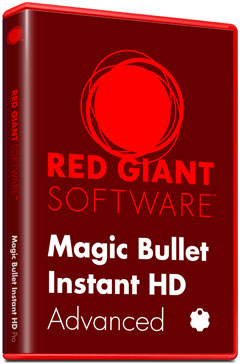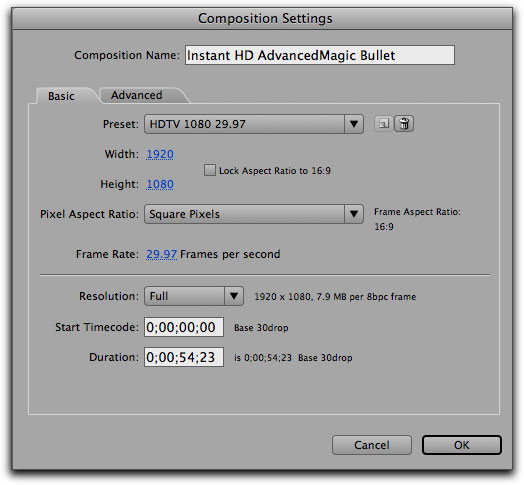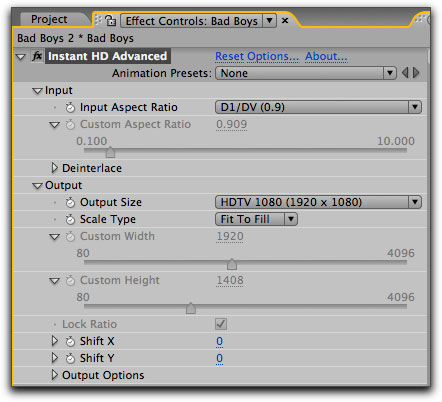

August 4, 2008
Red Giant Software's Magic Bullet Instant HD Advanced
www.redgiantsoftware.com
$399.00-new, $299.00-Cross-grade
Review by Steve Douglas
There are still a great many videographers and editors with large libraries of Standard Definition footage who long to integrate much of that footage, especially those once in a lifetime captures, within their new projects and HD or HDV sequences.
Back in June 2006 I reviewed Magic Bullets' Instant HD, a program designed to help the editor incorporate Standard Definition footage into an HDV or HD sequence. It was designed for users of Final Cut Pro 4.1+ and Adobe After Effects 6.0+ and worked its magic by up scaling the source footage. It did its job well though it was not accompanied by the easiest workflow in the world. However, at that time, the user guide was well written and thus the workflow could be followed if you had the time on your hands. The only real problem was that there was some noticeable resolution loss as a result of the up scaling. It was not severe but could be observed by the sharp eye.
While Instant HD Advanced is not compatible with Final Cut Pro as their original Instant HD had been, for 2008 Magic Bullet has both simplified the workflow as well as made some significant improvements in the software. Now compatible for Mac OS 10.5.2 with a minimum of 1GB of ram and 30 MB of hard drive space or PC/Windows, Magic Bullet Instant HD is geared for either the After Effects 7 or CS3 user.
I'm not going to pretend for you that I am an expert regarding multi-vector motion analysis, but that is really the heart of Instant HD Advanced. This analysis is what brings about the sharp output and cleanly accurate frames from previously interlaced SD source footage. According to Red Giant, it is the motion vectors that contribute to producing the excellent resolution resultant from the application of Instant HD Advanced.
So as to avoid any loss of resolution when up converting your standard definition footage to HD, Red Giant has developed algorithms which compare each pixel over successive frames. This then determines each frames' true edges providing for greater detailing and sharper results.
In addition, Instant HD Advanced now uses mult-core optimization on intel-based computers that, for anyone used to the drudgery of waiting for something to render in After Effects, will be a welcome relieve as render times are significantly reduced.
In use, once I settled upon the correct settings, the entire process of up converting some ancient DV footage to fit an HDV timeline was considerably easier to accomplish than with the old version of Instant HD. One just imports their footage in Adobe After Effects, and drags the footage into a new composition. This is the same as you would do for any work in After Effects.

Frame from the original Standard Definition footage. No filters or color correction applied.
Then it is up to the Composition Settings where you set things to the way you want your output to be.

Here I changed the composition settings so the 4:3 clip will sequester nicely into an HDV sequence.
In my case, I used HDTV 1080 29.97fps. I applied the Magic Bullet Instant HD Advanced plug in to the footage and went to the Effects Control window. Here I set the Output size to match the composition size and changed the Scale Type to 'Fit To Fill'. For those now shooting in 2K, the 2K settings provided in Instant HD Advance provide an easy way to scale the media to 2K resolution. Two dimension are offered. SMPTE 2K is the 2K version used to edit 2K media with 1080 lines. This is commonly used for digital cinema distribution. The ability to save for future use any custom presets you might use is part of Instant HD as well.

The Instant HD Advanced, now open in the AE Effects window has a number of controllable parameters,
but for those wanting a quick start and integration of their SD clips into a different format,
a simple change of your output size and scale type to match your comp settings will suffice.
At this point, as you normally would do when ready to render, bring your clip to the render queue, check the queue settings and render away.
A four second clip took 3min 28sec to render in After Effects which is typical of what I have learned to expect when rendering anything in AE. However, the render time is shorter than it was with the original version of Instant HD and the results are vastly improved.


The same frame side by side. With the now up converted 16x9 frame, you can see that the original lines are nicely kept with no viable distortion evident.
Do not expect your old Standard Definition footage to suddenly look as if it were now shot in HD. Nothing I know of will magically convert lesser quality source clips into higher quality footage. However, what Red Giant Softwares' Instant HD Advanced will do, is to allow you to utilize your DV footage in HDV or HD sequences without any obvious loss in either detail or color resolution from its original source. Of course, there is some scaling involved in the Instant HD Advanced algorithm. However, from the example below, you can see that it does not deviate very much from the original.


Notice the missing eye and lower jaw from this frame.
This, however, is based upon the default settings. Adjustments can be made however by using the custom settings parameter controls.
As I often note in the reviews I write, Red Giant Software is one of those companies that, in the interest of customer service, provides video tutorials on their website. This can be very helpful to anyone just getting started with new plug ins. While a tutorial for Instant HD Advanced is not up there yet, I am sure that in due time it will be. I have always found the folk at Magic Bullet to provide excellent tech support and within a very reasonable timeframe. As I noted in my review of Magic Bullet Looks, they continually seem to come up with serious and important improvements to most every application they produce. With Instant HD Advanced, they did just that. Editors would not use Magic Bullet's Instant HD Advanced to convert entire sequences, but will find it as an arsenal tool for short clip inclusion. My bottom line is that they succeed. Instant HD Advanced fits the bill just as they advertise. They have provided a simpler workflow, faster results and a higher quality output to an already excellent and useful editing tool.
 Steve Douglas is a certified Apple Pro for Final Cut Pro 6 and underwater videographer. A winner of the 1999 Pacific Coast Underwater Film Competition, 2003 IVIE competition, 2004 Los Angeles Underwater Photographic competition, and the prestigious 2005 International Beneath the Sea Film Competition, where he also won the Stan Waterman Award for Excellence in Underwater Videography and 'Diver of the Year', Steve was a safety diver on the feature film "The Deep Blue Sea", contributed footage to the Seaworld Park's Atlantis production, the History channel's MegaDisaster show and other networks. Steve is one of the founding organizers of the San Diego UnderSea Film Exhibition and leads both underwater filming expeditions and African safaris with upcoming excursions to Indonesia and the Coco Islands, Costa Rica in 2008, Kenyan safari in Africa and the Red Sea for 2009, and Truk Lagoon in Micronesia for 2010. Feel free to contact him if you are interested in joining Steve on any of these exciting trips. www.worldfilmsandtravel.com
Steve Douglas is a certified Apple Pro for Final Cut Pro 6 and underwater videographer. A winner of the 1999 Pacific Coast Underwater Film Competition, 2003 IVIE competition, 2004 Los Angeles Underwater Photographic competition, and the prestigious 2005 International Beneath the Sea Film Competition, where he also won the Stan Waterman Award for Excellence in Underwater Videography and 'Diver of the Year', Steve was a safety diver on the feature film "The Deep Blue Sea", contributed footage to the Seaworld Park's Atlantis production, the History channel's MegaDisaster show and other networks. Steve is one of the founding organizers of the San Diego UnderSea Film Exhibition and leads both underwater filming expeditions and African safaris with upcoming excursions to Indonesia and the Coco Islands, Costa Rica in 2008, Kenyan safari in Africa and the Red Sea for 2009, and Truk Lagoon in Micronesia for 2010. Feel free to contact him if you are interested in joining Steve on any of these exciting trips. www.worldfilmsandtravel.com
[Top]
copyright © Steve Douglas 2008
© 2000 -2008 Ken Stone. All rights reserved. Apple, the Apple logo, Final
Cut Pro, Macintosh and Power Mac
are either registered trademarks or trademarks of Apple. Other
company and product names may be trademarks of their respective
owners.
All screen captures, images, and textual references are the property and trademark of their creators/owners/publishers.










 Steve Douglas is a certified Apple Pro for Final Cut Pro 6 and underwater videographer. A winner of the 1999 Pacific Coast Underwater Film Competition, 2003 IVIE competition, 2004 Los Angeles Underwater Photographic competition, and the prestigious 2005 International Beneath the Sea Film Competition, where he also won the Stan Waterman Award for Excellence in Underwater Videography and 'Diver of the Year', Steve was a safety diver on the feature film "The Deep Blue Sea", contributed footage to the Seaworld Park's Atlantis production, the History channel's MegaDisaster show and other networks. Steve is one of the founding organizers of the San Diego UnderSea Film Exhibition and leads both underwater filming expeditions and African safaris with upcoming excursions to Indonesia and the Coco Islands, Costa Rica in 2008, Kenyan safari in Africa and the Red Sea for 2009, and Truk Lagoon in Micronesia for 2010. Feel free to contact him if you are interested in joining Steve on any of these exciting trips.
Steve Douglas is a certified Apple Pro for Final Cut Pro 6 and underwater videographer. A winner of the 1999 Pacific Coast Underwater Film Competition, 2003 IVIE competition, 2004 Los Angeles Underwater Photographic competition, and the prestigious 2005 International Beneath the Sea Film Competition, where he also won the Stan Waterman Award for Excellence in Underwater Videography and 'Diver of the Year', Steve was a safety diver on the feature film "The Deep Blue Sea", contributed footage to the Seaworld Park's Atlantis production, the History channel's MegaDisaster show and other networks. Steve is one of the founding organizers of the San Diego UnderSea Film Exhibition and leads both underwater filming expeditions and African safaris with upcoming excursions to Indonesia and the Coco Islands, Costa Rica in 2008, Kenyan safari in Africa and the Red Sea for 2009, and Truk Lagoon in Micronesia for 2010. Feel free to contact him if you are interested in joining Steve on any of these exciting trips.